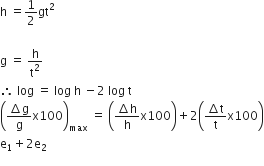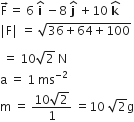A student measures the distance traversed in free fall of a body, initially at rest in a given time. He uses this data to estimate g, the acceleration due to gravity. If the maximum percentage errors in measurement of the distance and the time are e1 and e2 respectively, the percentage error in the estimation of g is
-
e1 - e2
-
e1 + 2e2
-
e1+ e2
-
e1 - 2e2
B.
e1 + 2e2







 acquires an acceleration of 1 ms-2. The mass of this body must be
acquires an acceleration of 1 ms-2. The mass of this body must be

